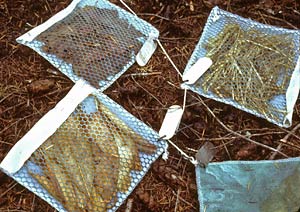
Simpler estimates of leaf decomposition rates
 One
of my favorite studies was by Cornelisson, who studied the rate
at which senescing leaves from 125 British plant species
decomposed. While other scientists carefully measured the
percentage of lignin, nitrogen, and tannins in the leaves, Cornelisson
wanted to know if he could predict the speed at which leaves broke down
using more easily measured plant characteristics.
One
of my favorite studies was by Cornelisson, who studied the rate
at which senescing leaves from 125 British plant species
decomposed. While other scientists carefully measured the
percentage of lignin, nitrogen, and tannins in the leaves, Cornelisson
wanted to know if he could predict the speed at which leaves broke down
using more easily measured plant characteristics.
He discovered that the
plants that decomposed fastest were woody
climbers, followed by flowering herbs, deciduous shrubs, deciduous
trees, grasses, and deciduous subshrubs. The leaves that were
slowest to decompose came from evergreens.
He also found that plant
family was related to speed of leaf
decomposition. From fastest to slowest decomposition were
Caprifoliaceae (Honeysuckle Family), Asteraceae (Composite Family),
Salicaceae (Willow Family), Fabaceae (Bean Family), Rosaceae (Rose
Family), Betulaceae (Birch Family), Poaceae (Grass Family), Pinacaceae
(Pine Family), Ericaceae (Blueberry Family), and Fagaceae (Oak
Family.) Perhaps this is a quick and dirty way to choose which
leaves to throw on the veggies and which on the trees?
Cornelissen,
J.H.C. 1996. An Experimental Comparison
of Leaf Decomposition Rates in a Wide Range of Temperate Plant Species
and Types. Journal
of Ecology.
84(4):573-582.
| This post is part of our Leaves for Fertility lunchtime series.
Read all of the entries: |
Want more in-depth information? Browse through our books.
Or explore more posts by date or by subject.
About us: Anna Hess and Mark Hamilton spent over a decade living self-sufficiently in the mountains of Virginia before moving north to start over from scratch in the foothills of Ohio. They've experimented with permaculture, no-till gardening, trailersteading, home-based microbusinesses and much more, writing about their adventures in both blogs and books.
Want to be notified when new comments are posted on this page? Click on the RSS button after you add a comment to subscribe to the comment feed, or simply check the box beside "email replies to me" while writing your comment.
